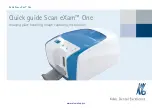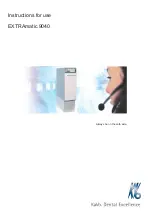
Troubleshooting
41
Graph Behavior:
The way the traceline of the graph displays during a test may be very helpful to understand a
test step. Below you will find images with common traceline drawings.
Inhalation valve not removed or propped open
When the inhalation valve is interfering with the fit test, this is what the traceline will look like. On
the adapter side with the two tubes attached, the airway needs a clear path into the respirator. If
the way is not clear, the above graph will appear.
1.
The inhalation valve can be propped open from the outside of the respirator before the adapter
is connected.
2.
Use an OHD valve prop to keep the valve intact and open during the fit test
(pictured here).
3.
If a valve prop is not available, other materials may be used. Take care not to damage
the valve when inserting an object to prop it open.
4.
For some respirators, it might be easier to remove the inhalation valves before the test, and then
replace them at the end of the fit test.
HIGH LEAKAGE - Large leak is measured
When the traceline does not lift above the bottom of the graph, this indicates that the
QuantiFit2 has detected a large leak in the respirator. This would be related to a leak in the
integrity of the respirator, a poor donning, or poor fit of the respirator.
1.
Check all tubing connections for secure attachment and confirm there are no holes or tears.
2.
Check to ensure that the QuantiFit2 respirator adapter is properly attached to the respirator.
Look for cross-threading, loose connection, etc.
3.
Check respirator for proper tightness to the face and check that no hair, beard stubble, unique
face characteristics, or other objects inhibit a good face-to-facepiece seal.
4.
Try a different respirator. Many respirators
seem
to fit well but are not properly sized to a specific
wearer. In other cases, a different size or style may be better suited for the individual wearer.
Summary of Contents for QuantiFit 2
Page 53: ...Appendix D CNP Diagram 52...
Page 108: ...Appendix D CNP Diagram 52...
















































